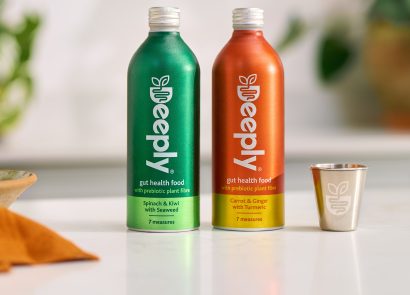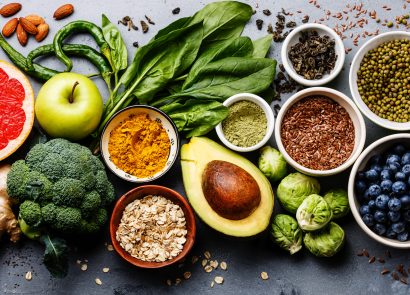In the past year, you’ll have undoubtedly noticed that vegan and free-from foods have flooded the supermarket shelves. With plenty of meat-, dairy-, and gluten-free options available, there’s now plenty of choice for everyone. But, if you’re turning over the back of a packet and wondering what all the ingredients are (and what they actually do to your body), Sarah Anderson, Harley Street nutritionist (sarahandersonnutrition.co.uk), is here to help to us learn what’s inside all these replacement products]
Inside mock meat
If you’ve walked up and down the supermarket aisle, you’ve probably seen the veggie and vegan-friendly alternatives to your classic beef burger. Some of these products are made from vegetables, but others contain protein from nonanimal- based sources, such as seitan which is wheatbased, tempeh which is soybased, and pea protein which is made from yellow peas. These protein substitutes are added to foods such as yoghurt, snack bars and even your staple salad condiment – mayonnaise. “Food manufacturers are quick to jump onto trends, and now meat products are falling out of favour with the market, the simplest thing for them to do is to remove the meat and use replacement products, including pea protein,” says Sarah. Extracted from yellow split peas, followed by a drying and rehydration process, pea protein contains some amino acids, such as arginine, which can help lower blood pressure. However, it’s not a complete protein and therefore doesn’t come with all the essential muscle-building amino acids your body needs. “While pea protein helps you with the repair process after exercising, it will go through a process before it comes out in burger form,” says Sarah. “Many protein products are filled with added sweeteners, flavours, colours, and preservatives.” The best sources of protein? “Beans, pulses, nuts, seeds and legumes,” says Sarah. “These are the most natural forms you can have, and to get the best of their nutrients, you can activate them by soaking them overnight.”
Inside your ‘gluten-free’ cake
Ever wondered what makes a lemon sponge gluten-free? Well, it probably won’t contain wheat or rye flour, but it will contain a replacement substance to give you an equivalent item. “Food manufacturers will add buzzwords to their products to make them more appealing to market trends,” explains Sarah. “Sometimes you’ll see a product labelled as wheat-free, but that doesn’t necessarily mean it’s gluten-free.” These food products don’t just contain gluten-free flours and flour blends, they also come with stabilisers and thickening agents, such as locust bean gum, a natural food additive that comes from the seeds of the carob tree. You’ll often see locust gum listed in the ingredients of the products such as breakfast cereals, bread and sauces. “Locust gum originates from a plant, but it’s still a food additive and so you’ll find it in processed products,” says Sarah. “If you do suffer from coeliac disease, then you’ll know that minimally processed fresh foods are a crucial part of a healthy gluten-free diet. Foods that are naturally gluten-free include fruits, vegetables, fresh meat, fish and legumes, as well as certain whole grains and oils. These are all unprocessed, and are more gut-friendly.”
Inside your coconut yogurt
One of the biggest current health concerns in the UK is sugar, so many food manufacturers have opted for sweet substitutes to give their products a similar taste. Often, it’s xylitol which is plant-based, but more recently, other sugar substitutes such as coconut sugar, have taken the market by storm. Coconut sugar is made from coconut palm sap, which is the sugary circulating fluid of the coconut plant. While it might be plant-based, it doesn’t necessarily make it any better than other food products containing sugar. “It’s still a form of sugar,” says Sarah. “This means it’s full of empty calories that your body will store as fat.” If you do want something sweet to snack on, foods that contain naturally occurring sugars, over added ones, are your best bet – try berries, bananas, mangoes and dates for that afternoon-slump sweet hit.
4 tips for decoding food labels
Do you read the back of food packaging packets and only able to pronounce a few words? Chances are you’re probably not alone. “Labelling has to get stricter,” says Sarah. “When you see words like whole foods, that doesn’t necessarily mean what’s inside will be processed efficiently.” Want to understand it all a bit better? Here are our top tips:
1. Watch out for hidden sugars that have been added to the product for preserving and flavouring reasons. A good rule of thumb is that anything ending in -ose, such as glucose, dextrose and maltose, is probably sugar.
2. Don’t just go off the front label, as research shows that adding health claims here makes people believe a product is healthier than it actually is. Food manufacturers will often add words they think will entice the consumer, such as whole-grain or fruitflavoured, even if the product is loaded with additives and preservatives.
3. When you look at a list of ingredients, they’ll be listed by quantity from highest to lowest. So, if the first three are whole foods, then the product is probably OK, but ditch anything with a list of ingredients that you’re struggling to pronounce.
4. Keep in mind that non-fat or low-fat foods probably contain sugar, a lot of salt, or a lot of artificial flavours. In most cases, the healthier option, is surprisingly the full-fat yoghurt!



















